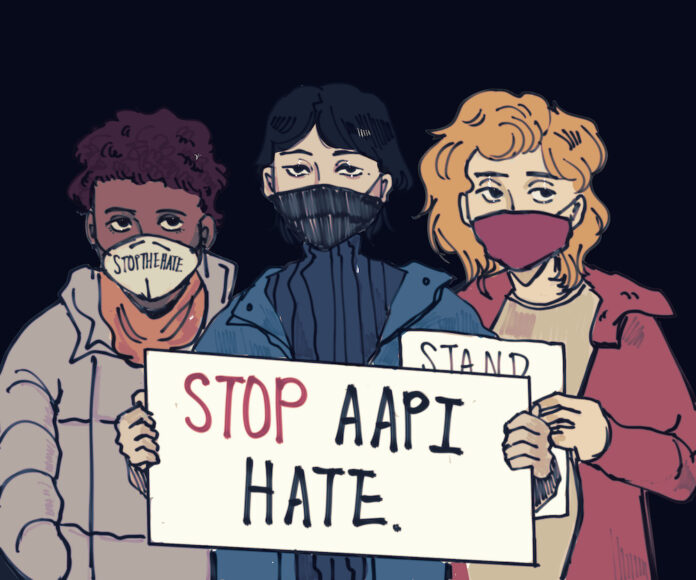Anger. Sadness. Frustration. Fear. These are the emotions that members of the Asian American Pacific Islander (AAPI) community at Occidental have expressed in the wake of a recent rise in violence against Asian Americans across the country. Eva Ma (junior) is one of many students advocating for justice for Asian Americans and has worked with fellow students and faculty members to create a document of resources to support the AAPI community. She said she felt many emotions in response to the anti-Asian violence.
“As an Asian American, I feel anger, pain and fear,” Ma said. “I am angry that people hold so much hatred, ignorance and intolerance in their hearts.”
Across the United States, 3,795 hate incidents against Asian Americans were reported from March 19, 2020, to Feb. 28, 2021, although this number could be higher because hate crimes are often underreported. In 2021 alone, Asians and Asian Americans have been the victims of many hate-crimes. Vicha Ratanapakdee, an 84-year-old Thai man, was pushed and killed in San Francisco. Noel Quintana, a 61-year-old Filipino man was slashed across the face with a box cutter in a New York City train car. In Atlanta, a man attacked three spas March 16, leaving eight people dead, six of whom were Asian women.
These hate incidents have taken place amidst the COVID-19 pandemic and former President Donald Trump’s xenophobic rhetoric, but these events are not solely attributable to this moment; Ma said there has been a long history of violence and discrimination against Asians in the United States.
“The Sinophobic and xenophobic rhetoric surrounding COVID that has called it the ‘Kung flu’ or ‘Chinese virus’ is only partially responsible. Anti-Asian hate has been around in America for over a century, and the way that it’s been erased, ignored and normalized certainly plays a role as well,” Ma said. “The yellow peril concept and the Chinese Exclusion Act are some historical examples that I don’t see talked about often enough.”
American Studies professor Xiao-huang Yin also said there has been a long history of xenophobia predating COVID-19, particularly with the scapegoating of Asians in the United States.
“Historically, Asian Americans, as a small minority group, were used by racists as scapegoats to channel anger and frustration for crises and problems in U.S. society,” Yin said via e-mail. “It happened in the 19th century when Chinese immigrants were accused of the economic crises and job competition or during World War II when Japanese Americans were blamed for the Pearl Harbor disaster.”
Urban & Environmental Policy (UEP) professor Martha Matsuoka said she has found past and current media coverage and portrayal of Asians to be problematic.
“There’s the model minority myth, there’s the yellow peril, and these things have never been fully resolved and they play against each other all the time,” Matsuoka said.
Yellow peril started in the mid-19th century and refers to the fears that Asians, particularly Chinese immigrants, would take land away from white Americans and threaten their Western values. These fears led to the Chinese Exclusion Act in 1882, which severely limited Chinese immigration until 1943. This concept contrasts with the model minority myth, which is the portrayal of Asian Americans as a monolithic group that has achieved economic and academic success through hard work and staying quiet on political issues. By downplaying the struggles unique to each minority group, this narrative pits the Asian community against other marginalized groups and has made it harder for these groups to come together to create institutional change.
Kevin Conroy ‘20 said he believes the media today still divides the Black and Asian communities by covering Black on Asian crime more than white on Asian crime.
“Generally, the media is going to be portraying it as Black on Asian crime and that derails the entire conversation and it makes the Black community very defensive since it looks like the Asian community as a whole is blaming the Black community,” Conroy said. “Whereas, in reality, the news media turns the Asian community against the Black community.”
Rather than divide and blame, politics professor Tsung Chi said it is important for minority groups to come together and stand up to racism and hate against any group.
“We know if there’s discrimination against one group, there will be discrimination against all groups,” Chi said. “People of all backgrounds and from countries should get united to fight together against the recent wave of anti-Asian discrimination and anti-Asian hate crimes.”
Matsuoka said it’s important to recognize the histories of people of color in the United States and think about the broader connecting links between groups.
“We have to figure out as Asians, and people of color in general, how we are going to connect our histories together, connect our futures together without falling into the trap of being separated and the wedge that comes between us by white supremacy, misogyny, race, class, gender and nation,” Matsuoka said.
Chris Arguedas, director of the Intercultural Community Center (ICC), said it is important to recognize how many marginalized groups’ issues are interconnected.
“Whether that be the Black Community working with the AAPI community or any marginalized group working together,” Arguedas said. “The way I think about it is collective action and collective care and understanding that so many of these issues are bound up together.”
According to Arguedas, students looking for a place to start advocacy work or who want a community to talk through these issues amidst this difficult situation can reach out to icc@oxy.edu or visit their website.
“There are systemic issues and a long history of the normalization of anti-Asian hate. I won’t accept it. I want to change it. I think we need to move away from the ‘it is what it is’ attitude. These issues are not going to go away on their own, so we can’t just accept them and move on,” Ma said. “We must demand institutional and systemic change.”
DJ Prakash contributed reporting for this article.
![]()




































